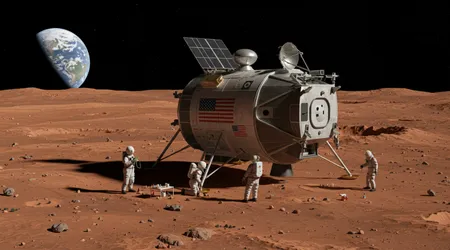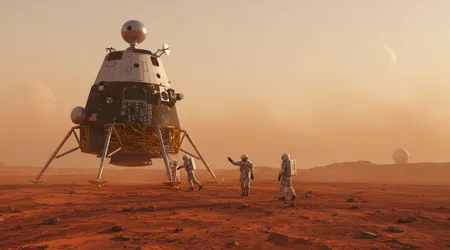Could We Have Gone to Mars Instead of the Moon in the 1960s?

The question of whether humanity Mars Instead of the Moon in the 1960s is a fascinating intersection of engineering, politics, and historical context.
Anúncios
The Apollo program achieved what many deemed impossible: landing humans on the Moon just eight years after President Kennedy’s monumental challenge.
It required a colossal national effort, massive financial resources, and groundbreaking technological leaps. Yet, why stop at 240,000 miles? Why not push for the truly audacious goal the 34 million-mile journey to Mars?
To answer this, we must strip away the nostalgia and look coldly at the technological limitations and political realities of the Cold War era.
While the theoretical physics allowed for the journey, the engineering reality, the financial commitment, and the overwhelming biological risks made a 1960s Mars landing a near-certain suicide mission.
Anúncios
The Moon was an achievable “stepping stone,” a necessary technological testbed; Mars was, and remains, a vastly different proposition.
The Tyranny of Trajectory: Delta-V and the Energy Barrier
The core reason NASA chose the Moon was the fundamental physics of orbital mechanics, specifically the immense energy required for any deep-space journey, known as Delta-V (change in velocity).
The Exponential Leap in Fuel
Reaching the Moon requires a substantial Delta-V, but the journey to Mars requires an exponentially larger boost. The Moon trip required a single, monumental burn of the Saturn V rocket.
A Mars mission, however, would require significant additional fuel for the return journey, an orbit-insertion burn at Mars, and the crucial Earth-return burn.
Carrying that extra mass fuel, habitat, and life support for a multi-year trip would have required a rocket far larger than the Saturn V, perhaps two or three times its capacity. The Saturn V, the largest rocket ever successfully launched, was already pushed to its limits just for the Lunar mission.
Engineers simply did not possess the propulsion technology or the means to assemble such a massive structure in Earth orbit in the 1960s.
The challenge wasn’t just building a bigger engine; it was designing the entire launch and orbital assembly infrastructure from scratch, a task that would have easily pushed the deadline into the late 1980s.
++ What’s Artemis II’s Orion ‘Integrity’ Spacecraft?
The Unforgiving Launch Window
The geometry of the solar system dictates that a Mars mission can only be launched during specific, infrequent synodic periods roughly every 26 months. Missing that window meant waiting over two years for the next opportunity.
The Apollo program, in contrast, offered frequent launch opportunities, allowing engineers to test, fail, and relaunch relatively quickly. The strict, unforgiving two-year launch window for Mars added an immense layer of pressure and delay.
This logistical nightmare meant the political window to achieve the goal quickly would have slammed shut, making the proposition of Mars Instead of the Moon in the 1960s an immediate political liability.

Biological Barriers: Radiation, Isolation, and Time
Beyond the sheer physics of propulsion, the biological and psychological challenges of a Mars mission in the 1960s were effectively insurmountable. Astronaut safety was, and is, paramount.
The Gauntlet of Deep Space Radiation
The Moon mission lasted about eight days, keeping astronauts exposed to deep space radiation for a minimal period. A round trip to Mars, utilizing a Hohmann transfer orbit, takes between 18 months and three years, depending on the orbit chosen.
Also read: Lessons from the Challenger Disaster That Still Matter Today
Solar Particle Events and Galactic Cosmic Rays
During the 1960s, scientists had only basic knowledge of Galactic Cosmic Rays (GCRs) and the devastating, unpredictable danger of Solar Particle Events (SPEs). SPEs, massive solar flares, can deliver lethal doses of radiation in minutes.
Shielding a spacecraft for a three-year mission against both GCRs and SPEs requires meters of water or dense material, adding prohibitive weight.
Astronauts in the 1960s simply lacked the necessary heavy shielding for a long-duration flight. The crew would have almost certainly surpassed lifetime radiation exposure limits, risking catastrophic health effects.
This single factor alone provided a definitive, non-negotiable roadblock to attempting Mars Instead of the Moon in the 1960s.
Read more: The Overlooked History of African Contributions to Space Science
The Psychological Toll of Isolation
NASA had no infrastructure for long-term psychological support or monitoring in deep space during that era. The Apollo crew could always see Earth and maintain near-real-time communication (with a 2-second lag).
A Mars mission involves months of total isolation, with communications lagging by up to 22 minutes one way. The psychological support required for a three-year mission in a confined capsule dealing with potential conflict, loneliness, and mission stress was entirely undeveloped.
The risk of behavioral health crises or interpersonal failure would have been extremely high, a risk NASA was not prepared to take.
Political and Financial Realities: The Cost of Cold War Glory

Space exploration is never purely scientific; it is a direct reflection of national political will and budgetary commitment. The Moon was a manageable, politically powerful goal; Mars was a financial abyss.
The Price Tag of the Impossible
The Apollo program cost roughly $25 billion between 1960 and 1973 (approximately $280 billion in 2024 dollars). This massive, singular expenditure was politically justified by the urgent “Space Race” against the Soviet Union.
A Mars mission, requiring entirely new life support systems, heavier shielding, and a multi-launch architecture (perhaps utilizing technologies like nuclear thermal propulsion which were only in early research stages), would have likely doubled or tripled the Apollo budget.
Such a request estimated by some historians as exceeding $75 billion in 1960s dollars would have been politically impossible to sell to the U.S. Congress, especially without the guarantee of beating the Soviets there.
Statistic: A 2023 analysis by the Center for Space Policy and Strategy (CSPS) determined that given the required technology gaps (heavy lift, closed-loop life support), the projected cost of a fully shielded and biologically safe manned Mars mission would have consumed approximately 5% of the entire 1965 U.S. Federal Budget for nearly a decade, a non-starter in a politically volatile era.
The Simplicity of the Lunar Goal
The genius of the Apollo goal was its simplicity: land a man on the Moon and return him safely before the end of the decade. This clear metric allowed NASA to streamline its mission planning, focusing all resources on the single objective.
A Mars mission would have involved dozens of complex, multi-year tests: testing closed-loop life support, developing advanced recycling systems, and creating heavy radiation shelters.
The inherent complexity would have diffused resources and guaranteed the program would fail to meet the “end of the decade” deadline. The Moon was the achievable geopolitical chess move; Mars was the strategically unsound gamble.
The Necessary Stepping Stone: Apollo as a Testbed
Apollo was never the end goal; it was the essential testbed for deep-space travel. The Moon served as a “local” training ground where mistakes could be made without the three-year consequence of failure.
Testing the Limits of Technology
The Moon mission validated the fundamental technologies required for any deep-space travel: trajectory corrections, orbital mechanics, remote navigation, and heat shield integrity during high-speed re-entry.
The failures of Apollo 1 (the fire) and the near-catastrophe of Apollo 13 demonstrated that even a trip to the Moon was operating on the knife-edge of known engineering limits.
The idea that NASA could bypass these essential learning steps and succeed at the much longer, more dangerous Mars mission is akin to deciding to fly a commercial jet before successfully building and testing a propeller plane.
The technological leap was simply too wide to bridge in a single decade. The Moon proved the basic concept; Mars required the next generation of technology.
The Analogy of the Deep Dive
Consider deep-sea exploration. The Moon is like diving a few hundred feet challenging, requiring specialized gear, but feasible with known technology.
Mars is like diving the Marianas Trench requiring exponentially stronger pressure hulls, entirely self-contained life support, and years of preparation. You don’t jump directly to the Trench.
You master the shallower depths first. The Moon was NASA’s essential shallow dive before even considering the deep space trench.
| Mission Parameter | Lunar Mission (Apollo) | Mars Mission (1960s Projection) | Impossibility Factor |
| Duration (Round Trip) | 8 – 10 days | 18 – 36 months | Extreme – Biological/Psychological |
| Communication Delay | 1 – 2 seconds | 3 – 22 minutes (one-way) | High – Crisis Management |
| Radiation Shielding | Minimal (acceptable risk) | Heavy, Prohibitive Weight | Extreme – Engineering/Weight |
| Propulsion Required | Single Saturn V (direct) | Multiple Saturn V launches (orbital assembly) | High – Technological Gap |
| Political Urgency | High (end of decade deadline) | Low (multi-decade project) | Political Non-Starter |
Conclusion: The Wisdom of the Limit
The analysis shows decisively that attempting Mars Instead of the Moon in the 1960s was not a feasible goal, even with the immense political will and resources dedicated to Apollo.
The Moon was the perfect challenge: difficult enough to necessitate innovation, yet close enough to be completed within a politically relevant timeframe and, crucially, safely. The limiting factors radiation exposure, massive propulsion requirements, and the immaturity of closed-loop life support were true technological walls, not just challenges.
The Apollo program was the foundation, proving the basic survival skills needed for deep space. The dream of Mars remains contingent upon the technological maturity that Apollo enabled.
We must appreciate the wisdom of the limit. What essential new technology do you think finally makes the manned Mars mission truly safe and feasible today? Share your thoughts on the next great leap in the comments below!
Frequently Asked Questions (FAQs)
Q: Why didn’t NASA just build a bigger rocket than the Saturn V?
A: Building a bigger rocket involves more than just scaling up the design. It requires new manufacturing facilities, new testing infrastructure, and solving massive stability and structural engineering problems related to handling the immense weight and thrust.
Such a project would have required an additional 5-10 years of development time, completely missing the 1960s deadline set by President Kennedy.
Q: Would using nuclear thermal propulsion (NTP) have made a Mars mission possible sooner?
A: Nuclear Thermal Propulsion (NTP) was indeed researched in the 1960s (Project NERVA) and offers much higher efficiency than chemical rockets. While NTP could significantly shorten the travel time to Mars (reducing radiation exposure), the technology was still experimental.
Crucially, the public and political safety concerns surrounding launching a nuclear reactor from Earth were, and still are, highly contentious, making it an unlikely choice for the highly visible, safety-focused Apollo era.
Q: Was there a Soviet plan to send humans to Mars in the 1960s?
A: The Soviet Union was intensely focused on beating the U.S. to the Moon and did not possess a credible, fully developed program for a manned Mars mission during the 1960s. Their ambition was mostly political propaganda.
They faced the same insurmountable engineering and biological challenges as the U.S. Any theoretical Soviet Mars mission would have been subject to the same severe radiation and propulsion constraints that made Mars Instead of the Moon in the 1960s impossible for the Americans.
